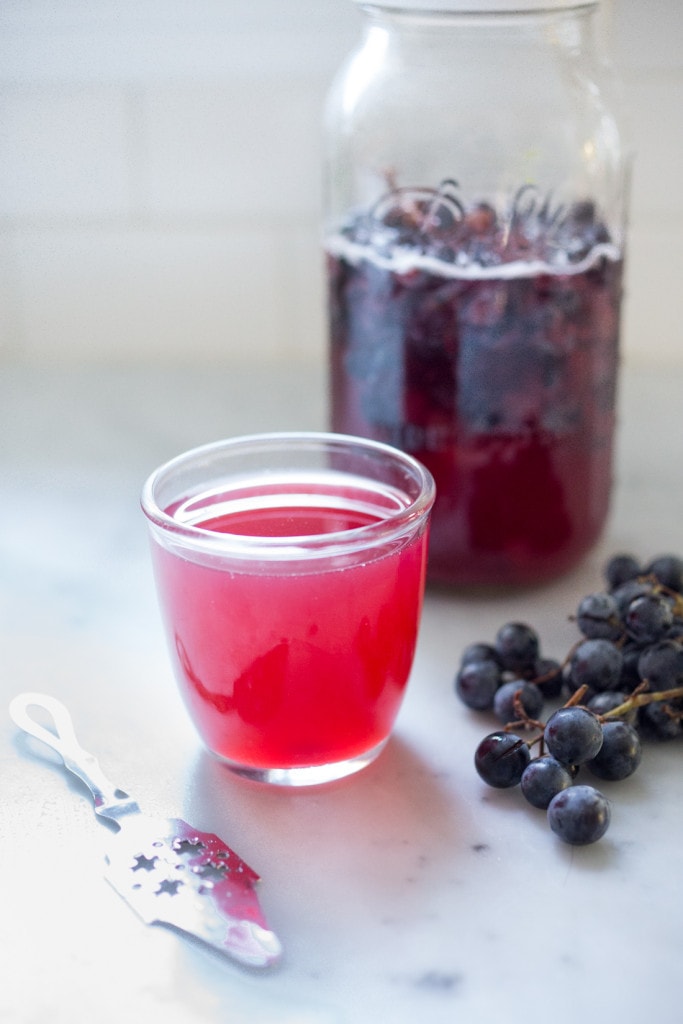

I want to introduce you to a happy, bubbly probiotic drink called water kefir!
This delicious, effervescent, fruit-infused water si full of healthy probiotics that support a healthy, diverse microbiome, clears the skin, and energizes the whole body. It’s similar to kombucha but without the caffeine!
The best part is that it is easy to make at home! I hadn’t heard of water kefir until a friend of mine, Bee (from H is For Love), introduced it to me a few years ago, and since then, I’ve been crazy, head-over-heels in love with it. We’ve been making batches and batches of this refreshing, healthy beverage all summer long.
It takes about 3-4 days to make Kefir Water, with only 15 minutes of hands-on time!
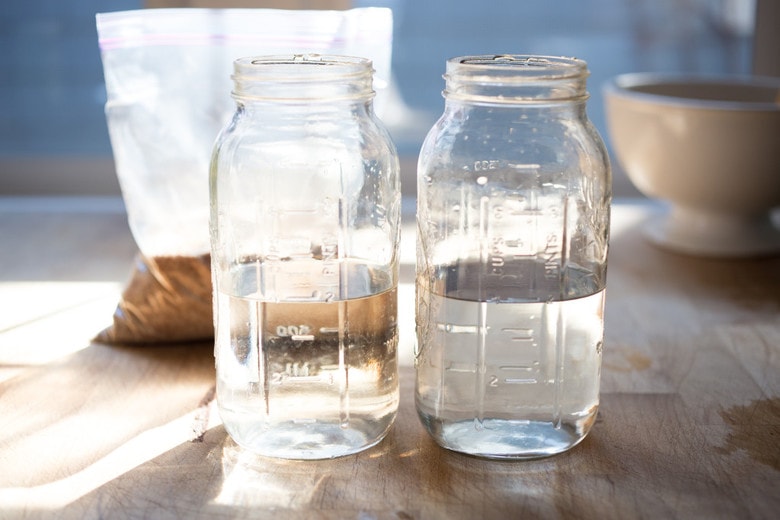
STEP TWO. To the water, mix in ¼ cup of organic cane sugar into each jar. I highly recommend making the “sugar mixture” in the recipe notes which contains more minerals (than white sugar) which keep the grains happy and help with fermentation.
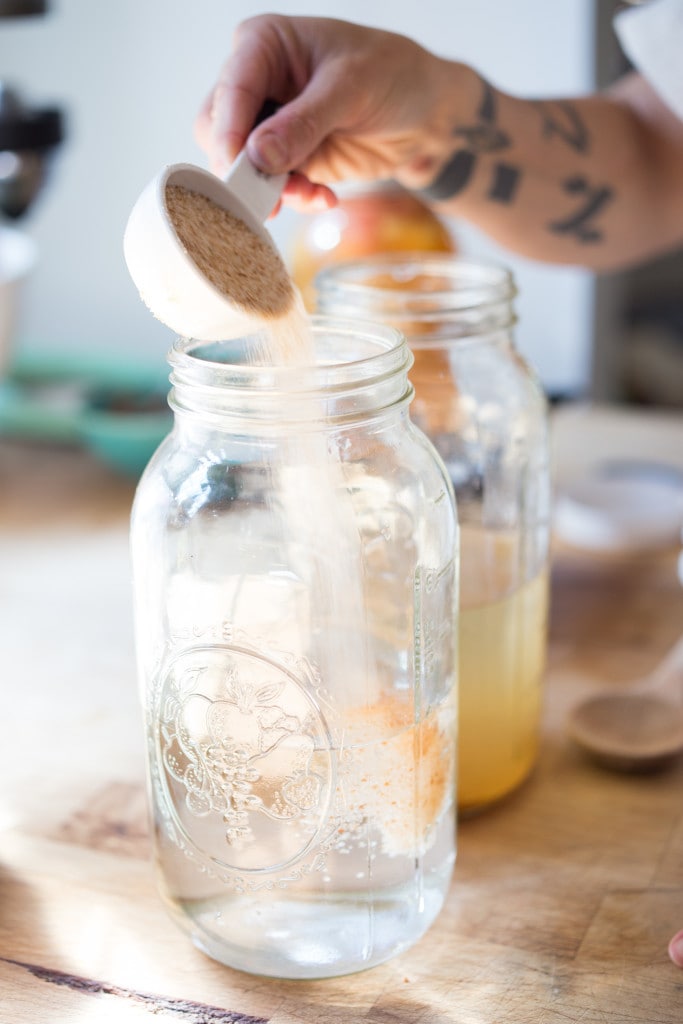
Now before you start thinking (like I did) that there is so much sugar in this, and how it must be so high in calories, remember, the kefir grains metabolize the sugar, which means they basically “eat” the sugar, (this is what feeds them) taking it out of the water. Once it’s done doing its thing, the water is only very mildly sweet, which I find completely and utterly fascinating!
From Yeemos: “Kefir grains are an amazing symbiotic matrix of bacteria and yeast that work together to feed off the natural sugars (and sometimes proteins and fats too, especially in the case of milk kefir) found present in the sugar-water and dried fruits. The yeast and bacteria cooperate, making the nutrients that are inaccessible to one digested into accessible nutrients for the other. Yeasts break down the simple sugars like glucose and fructose, turning them into ethanol and acetic acid. Lactic and acid-producing bacteria (such as lactobacilli) convert sugars (such as sucrose) and complex carbohydrates (starches, etc) into simpler sugars and lactic acid. Lactic and acetic acids naturally preserve as well as stave off harmful foreign bacteria. The result is a drink that has had much of the sugar converted to simpler sugars, lactic and acetic acids, carbon dioxide and ethanol. It also contains millions of probiotics and is more nutritious in some regards because of the more bio-available and digestible nutrients from the sugars and dried fruits including an increase in vitamin C and many B vitamins.” From Yemoos
Stir the sugar into the water with a wood spoon until dissolved.
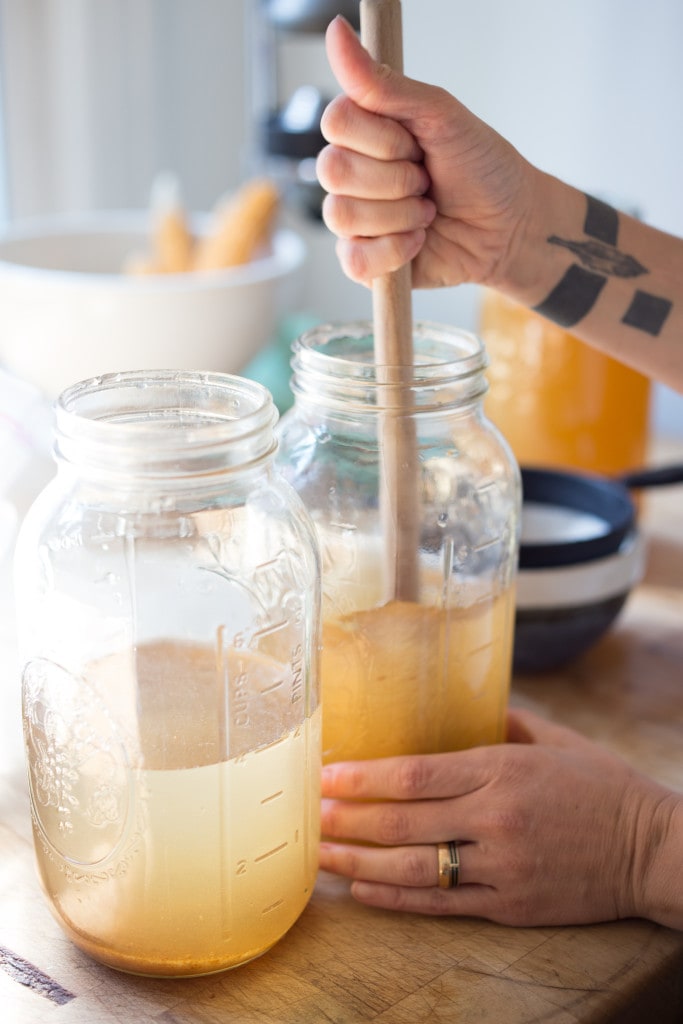
STEP THREE: Add 1/4 cup water kefir grains to each jar. Gently stir.
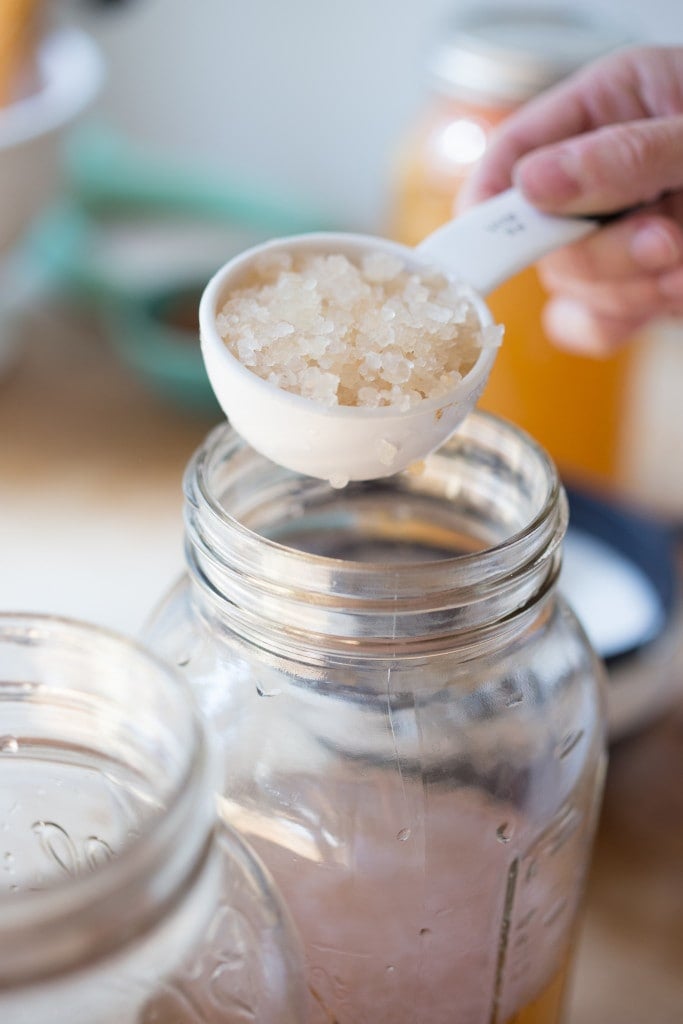
STEP FOUR: Add a big slice of lemon to each jar. Now if you are allergic to lemons, sub orange, lime or even grapefruit. The acidity here helps prevent the growth of Kahm yeast – a harmless yeast but one that could affect the taste.
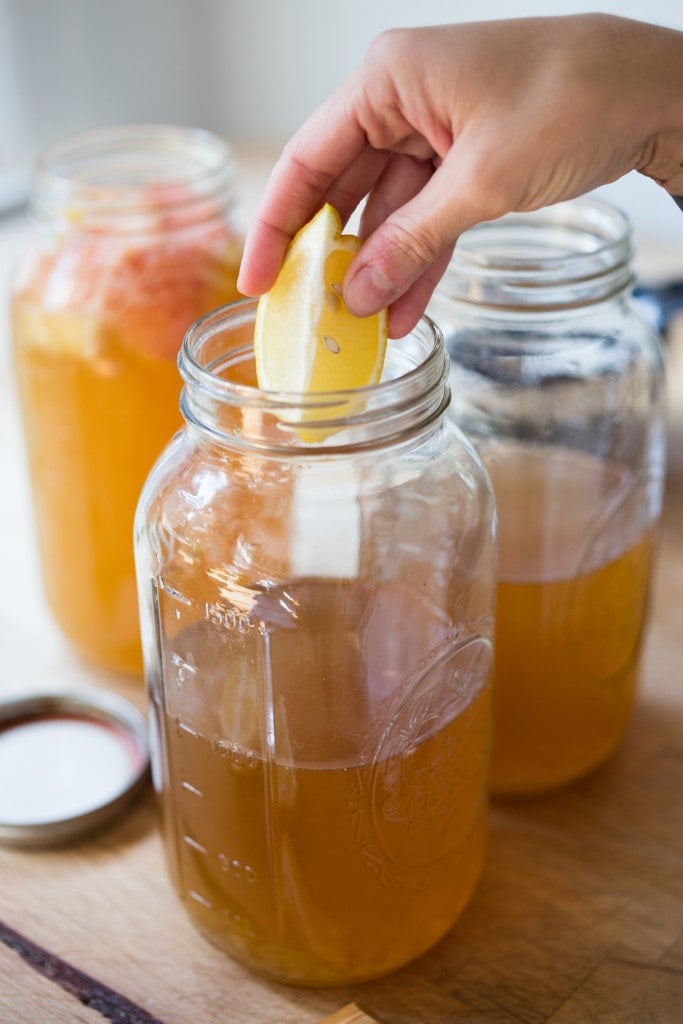
STEP FIVE: Add one prune to each jar. These seem to also boost fermentation. They are not imperative, but definitely add if you have them on hand. A dried fig, or a few raisins would work too.
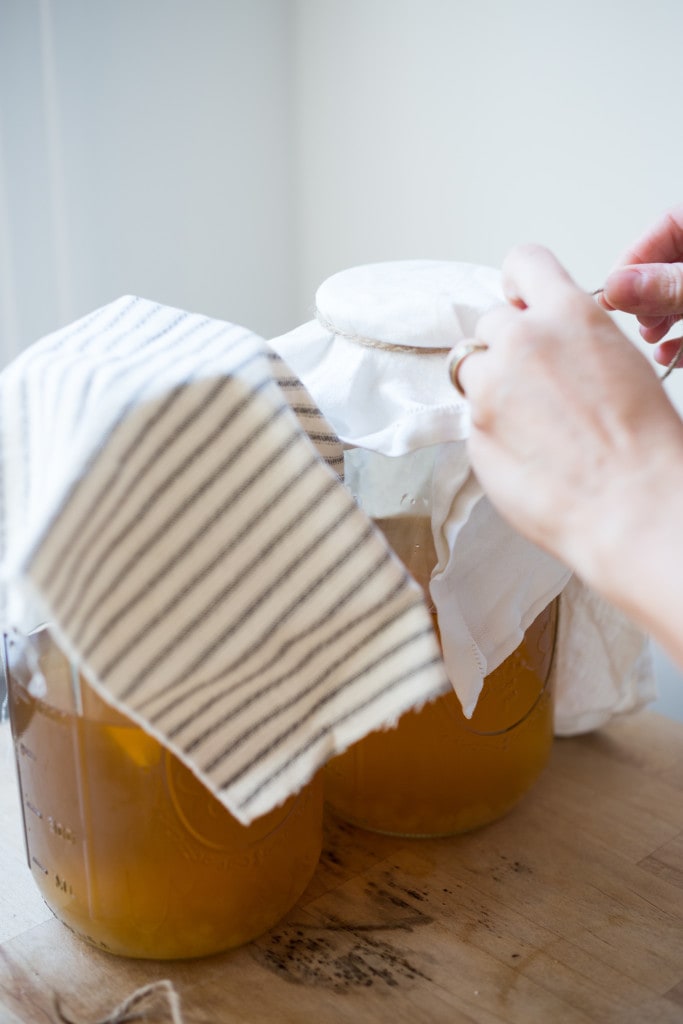
STEP SIX: Cover with a thin kitchen towel. It needs to breathe, but you want to prevent little fruit flies from getting in and seal it with twine or a rubber band. You could also top it with a coffee filter.
STEP SEVEN: The First Ferment. Let the jars sit on the kitchen counter at room temperature for 2-3 days. Two days if it’s warm out (in the summer), 3-4 days if it’s cold. Right now in fall, I’m leaving it out for 3 days.
Check for sweetness. After 2 or 3 days your kefir water should have fermented slightly – and you can check this by tasting it. If it tastes very sweet, then the sugar has not been metabolized and you need to ferment it longer. The longer it goes, the tangier it will taste and the less sweet it will get. You want it to taste balanced- just subtly sweet with a little bit of tangy. Find your own balance. If you taste no tanginess, it may not have fermented, a sign the kefir grains may not be healthy, active or alive.
TIP: Tangy or sour flavors tell you it has fermented. If it is not getting tangy or sour after 3-4 days, then your kefir grains may not be alive or active.
STEP EIGHT: Create your flavor. Place 1 – 1 1/2 cups fresh fruit in one clean 2-quart jar– like fresh berries, peaches, apricots, pineapple, plums, concord grapes, apples or pears. You can also add fresh herbs. Then strain both jars of the fermenting kefir into the third clean jar with the fresh fruit in it, straining out the kefir grains (set these aside) filling the jar to a ½ inch from the top. (Save the extra fermented water to store the grains in and place them in the fridge with 1 tablespoon sugar. Add more water to cover.)
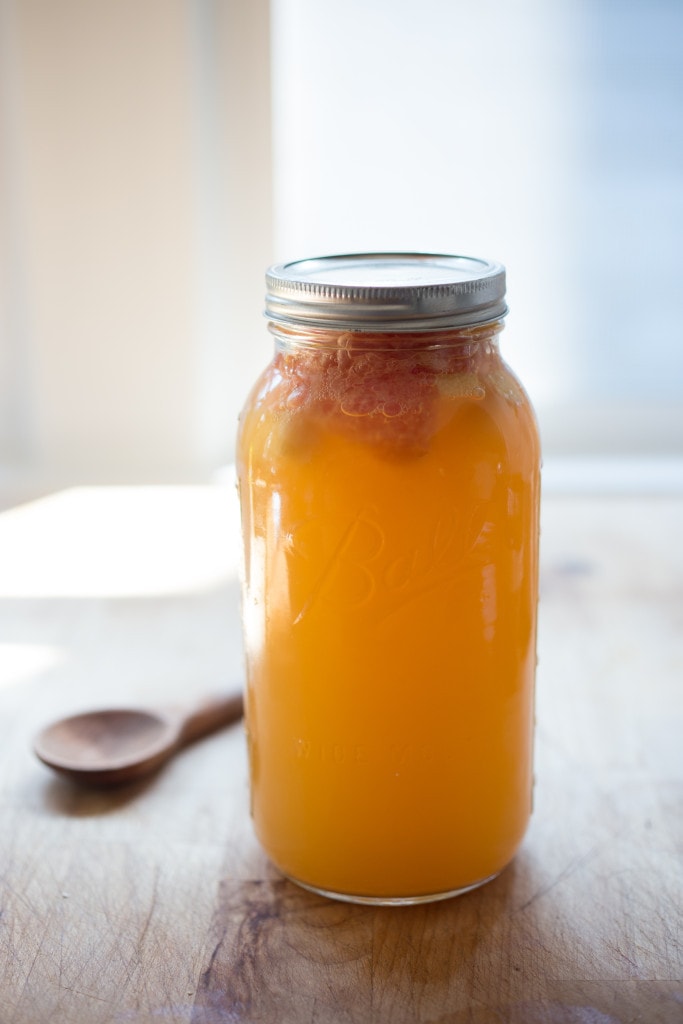
STEP NINE: The Second ferment. Once the fruit is added, cover tightly with a lid, and leave on the counter for another 24 hours. Your kefir should start bubbling. During the 2nd Ferment, the water kefir is creating gas and building pressure, which you want it to do – this makes it nice and bubbly, but with the metal lids, you must let out some of the pressure, “burping it” every 6-12 hours or so (depending on the temperature in your kitchen) so the lid doesn’t explode open (yes this happened to me). With a plastic lid, it stays on fine, and the air can escape. If using a metal lid, just screw the top on loosely until you feel the first resistance- this will allow some air to escape.
WARNING: These metal lids like in the photos above, have pros and cons. They allow pressure to build up, with their tight seal, creating bubbly effervescent kefir, but they can explode if the pressure is not released occasionally. They must be burped! If you need to leave your home and are worried about the jar exploding, simply loosen the lid while you are gone. Place the jar over a bowl to collect any runoff.
Plastic lids are “self-burping”, which if you are away from home for over 8 hours, I would recommend using. The downside is the plastic lids do not let the pressure build quite enough in my opinion so kefir is not quite as bubbly. Sometimes I switch between both, depending on if I am planning to be gone.
STEP NINE: After 24 hours, the fruit will float the surface and it’s time to refrigerate. You can strain the fruit, eat the fruit ( it won’t hurt you) or keep it in the water to infuse longer – I generally just leave it in, and strain it as I pour into a glass. Up to you.
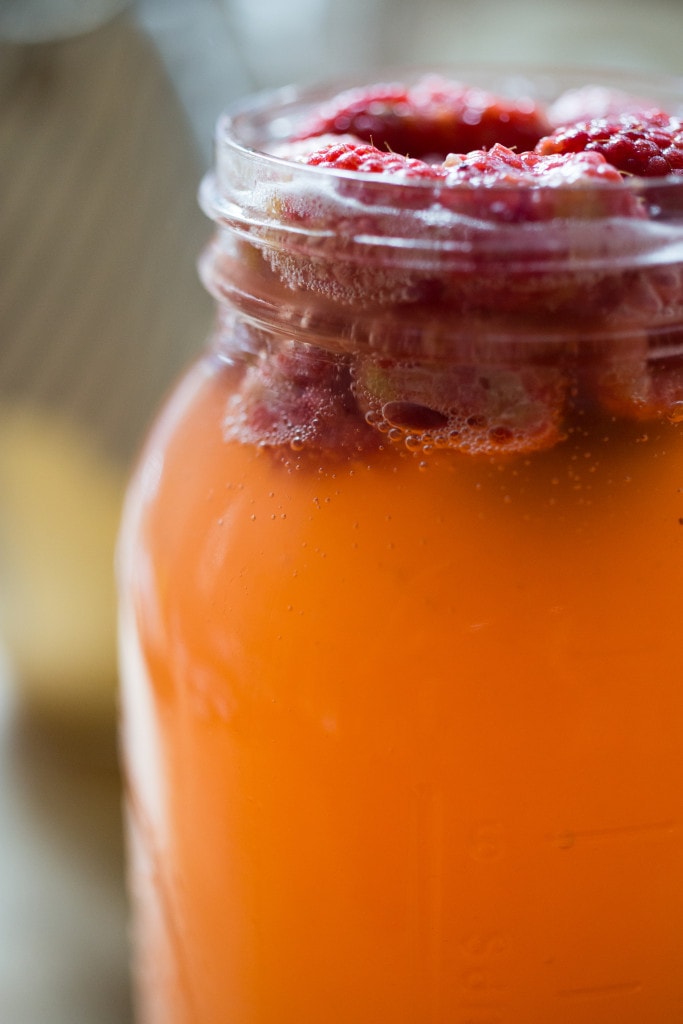
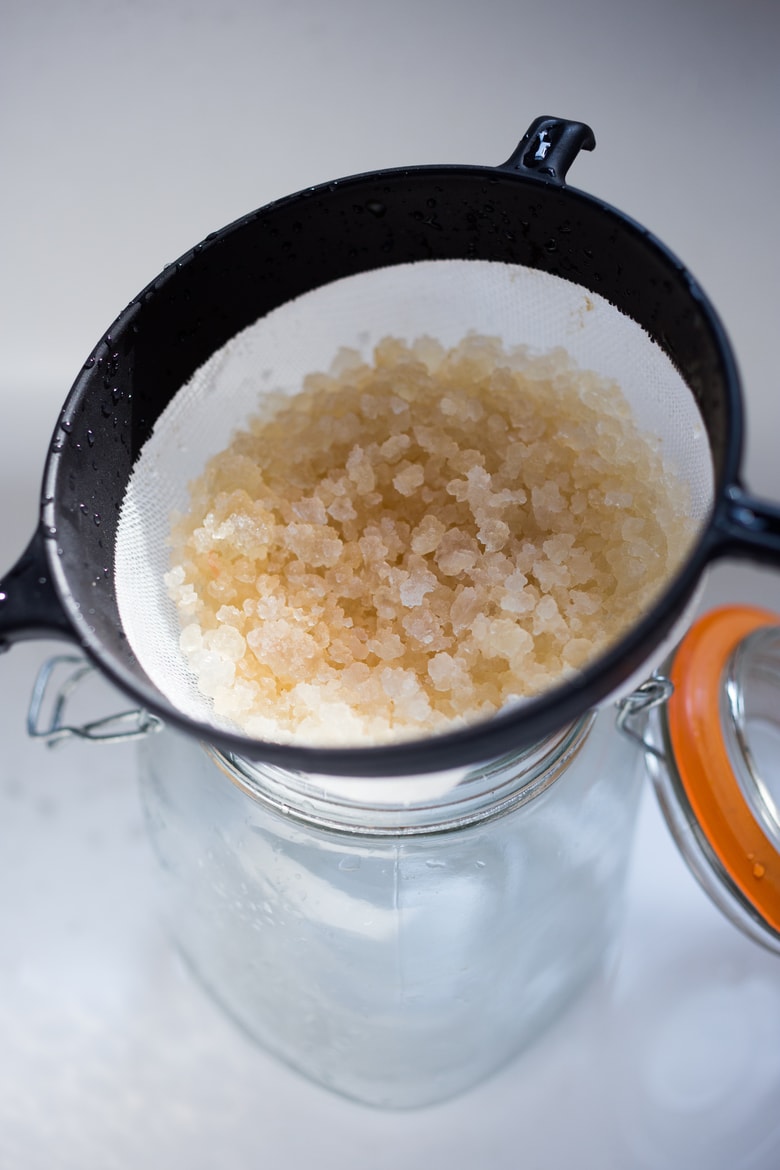
Once you get the hang of making water kefir- the variations are truly endless! I usually start with what is in season- seasonal fruits and berries and add from there. You can also add herbs, spices and even chia seeds!
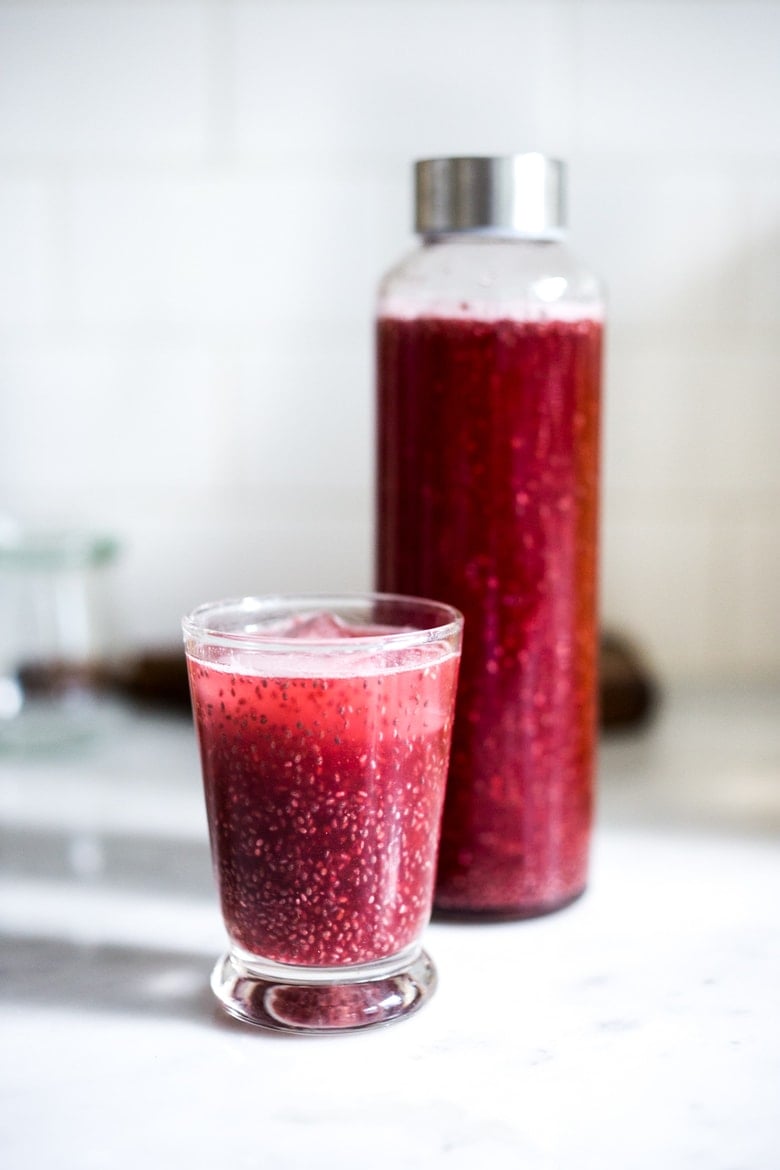
There are so many versions to make….. the possibilities are endless! Here above is Strawberry-Raspberry Water Kefir with Chia Seeds– energizing and refreshing!
Here below is peach ginger.
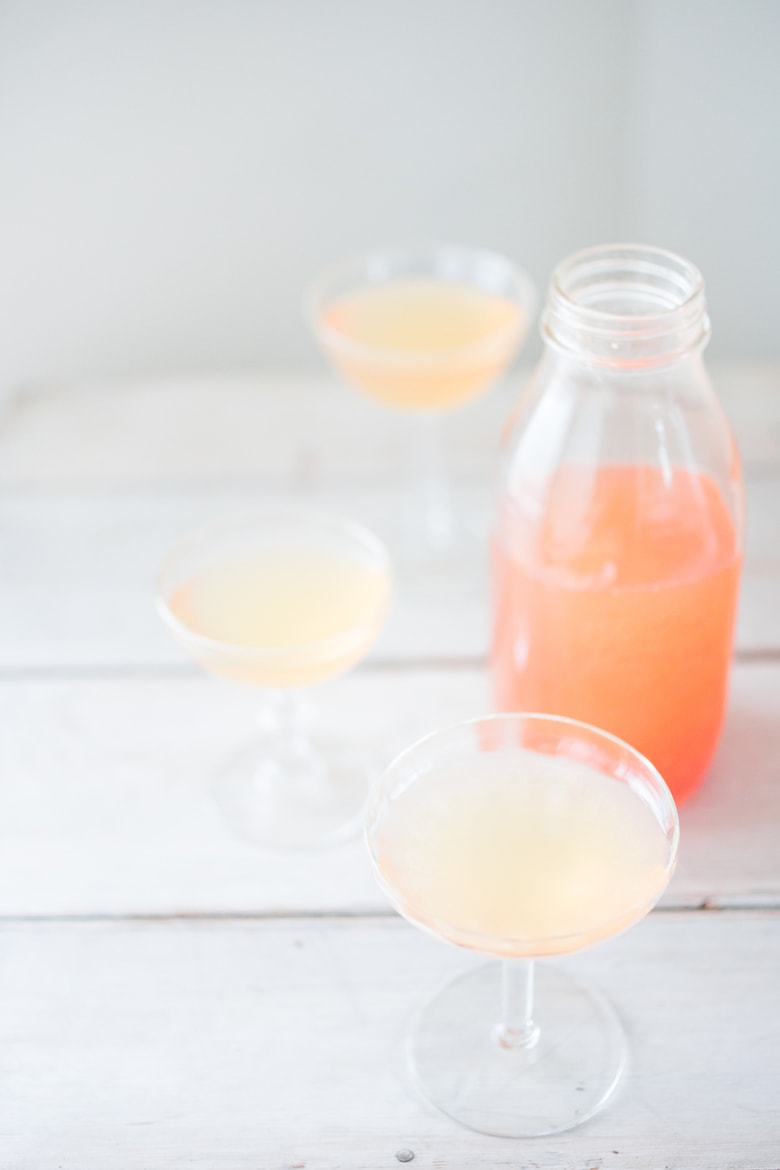
And here below is a Plum-Ginger Water Kefir with shiso leaves.
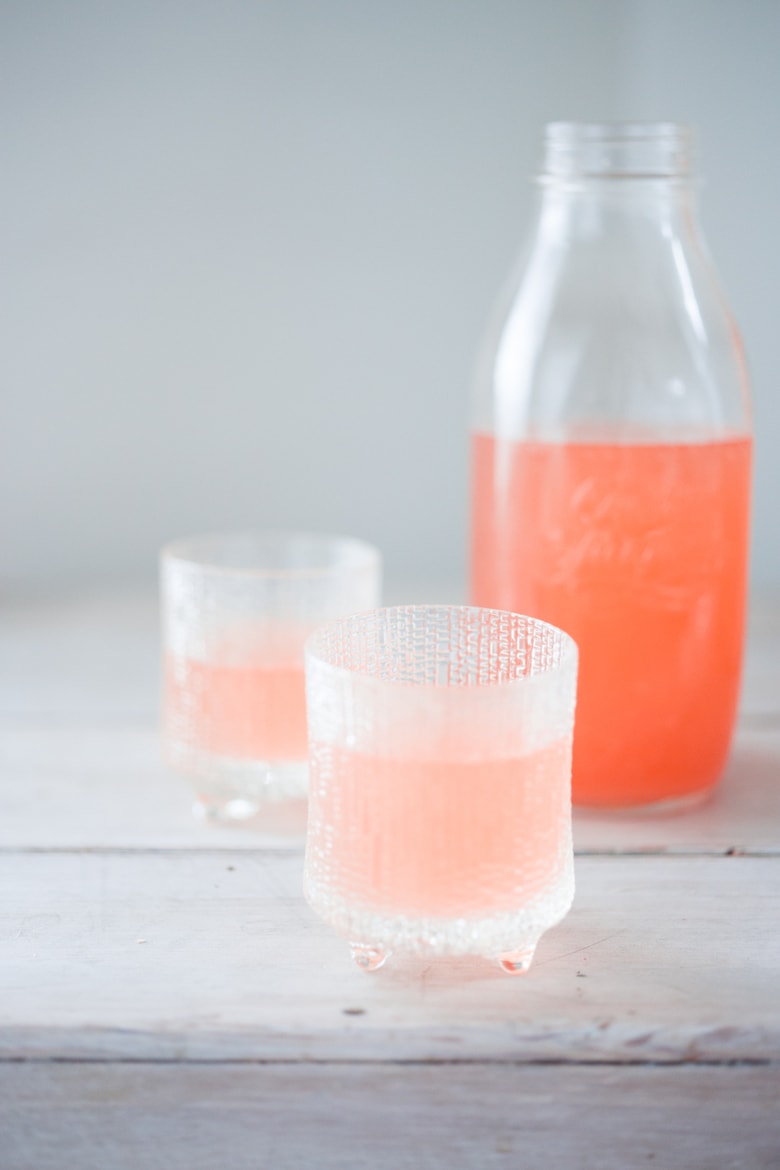
Here is Strawberry Basil Water Kefir!
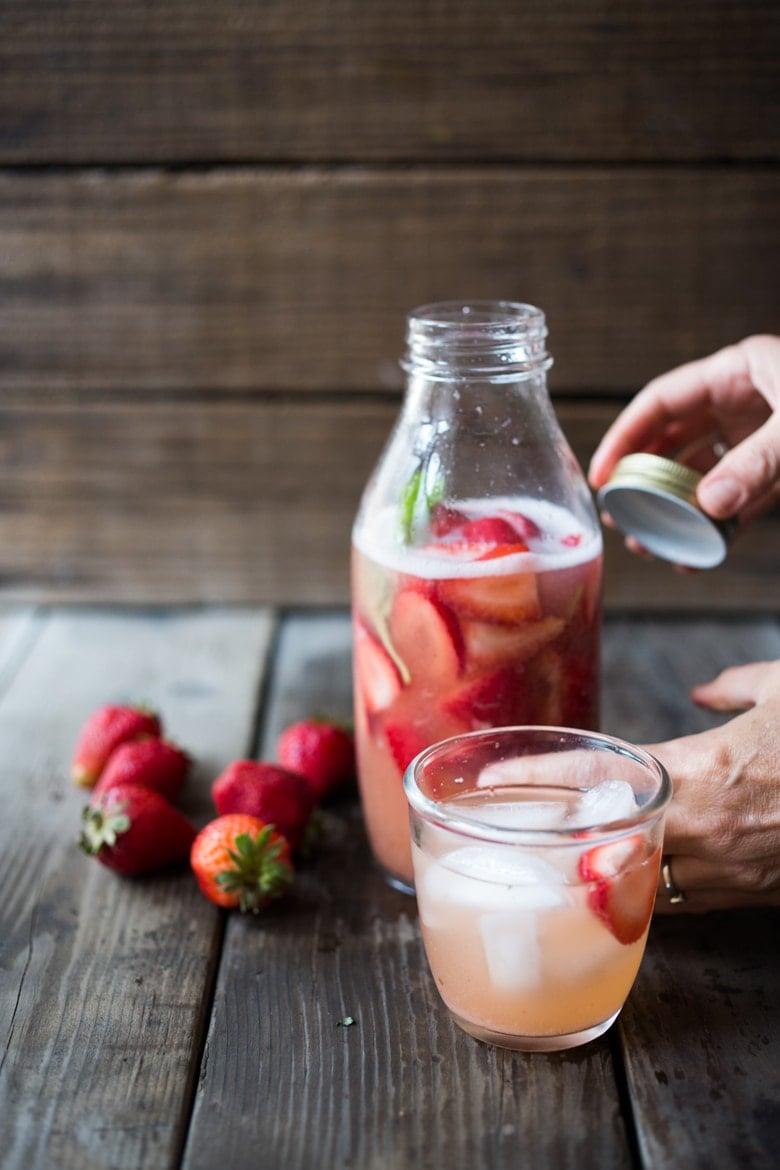
You’ll love how refreshing, tangy, fruity and delicious this is- so much better than a soda stream- with many more minerals, nutrients and probiotics.
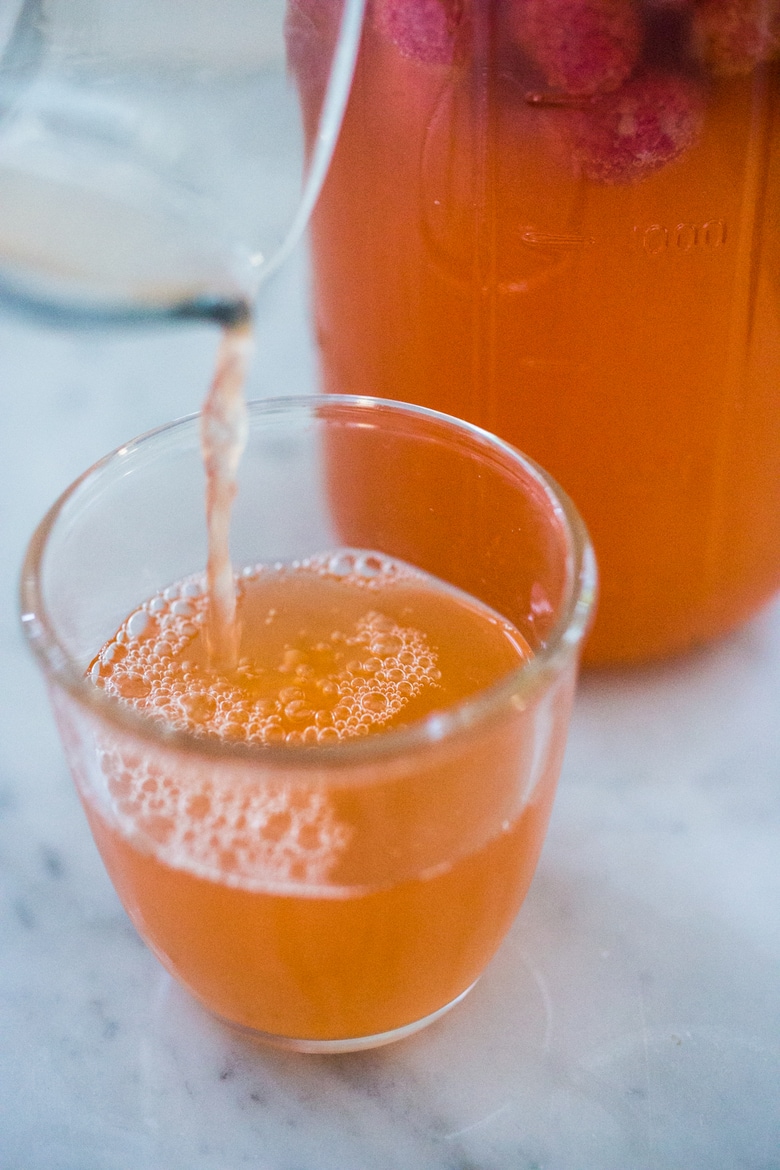
The possibilities are endless! Get some water kefir grains and give it a try!
Creating gut diversity is key to a healthy immune system. Water kefir is one of the best dietary sources of probiotics and can contain up to 40 different healthy bacteria strains including Lactobacillus casei, Lactobacillus nagelii, bifidobacteria, Lactobacillus hilgardii, lactic acid bacteria, Acetobacter spp. from acetic acid bacteria, and Saccharomyces cerevisiae.
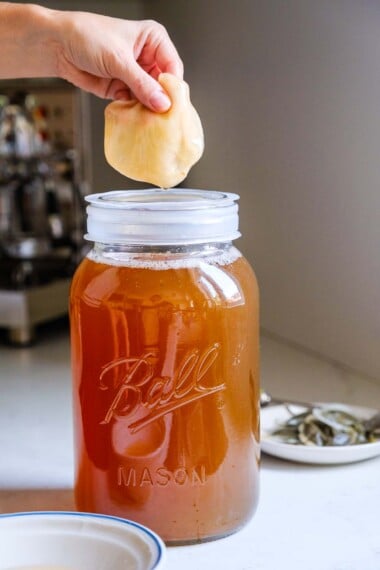
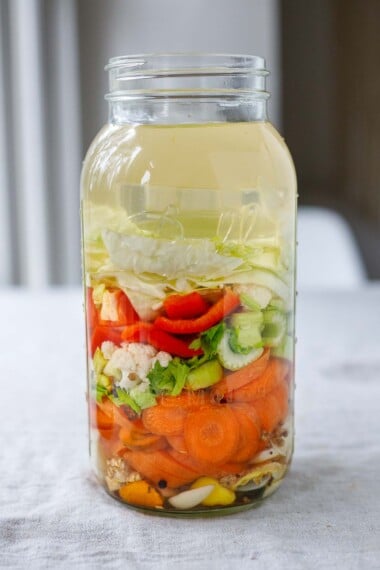 the Gut Shot is a fermented vegetable drink that supports gut health by creating diversity in the microbiome—an easy step-by-step guide using veggies you already have with just 15 minutes of hands-on time." width="380" height="570" />
the Gut Shot is a fermented vegetable drink that supports gut health by creating diversity in the microbiome—an easy step-by-step guide using veggies you already have with just 15 minutes of hands-on time." width="380" height="570" />
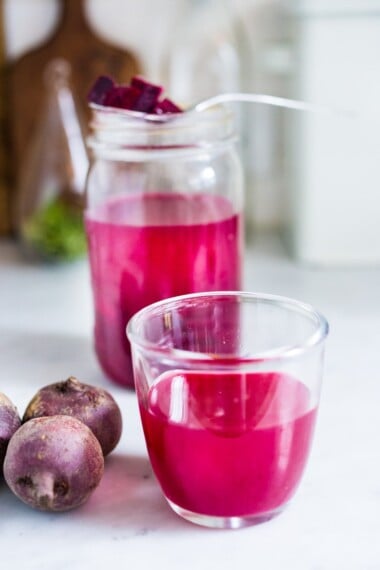
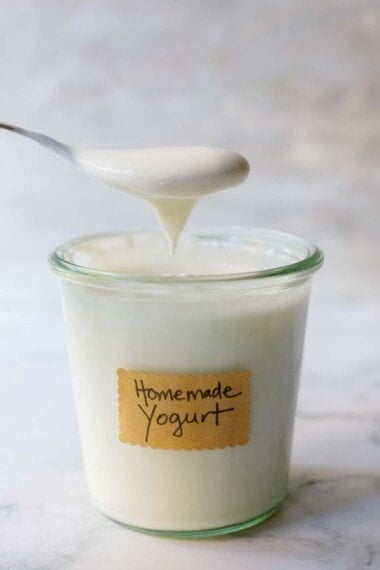
Water kefir is full of healthy probiotics that increase the diversity of good bacteria in our gut, the foundation of a healthy immune system. It’s low in sugar, and full of nutrients from fresh fruit.
Is there alcohol in Water Kefir?Water kefir is slightly fermented which can produce trace amounts of naturally occurring alcohol. This is typically around .02 % which equates to roughly ¼ teaspoon in a 12-ounce glass.
Can you drink Water Kefir every day?If your gut is healthy and diverse, yes! If you are new to consuming fermented foods, or have gut dysbiosis you may need to start off slowly and gently introduce it. Start with a few sips, and see how it feels, if ok, then try a quarter cup, see how you feel, and add from there. If you experience a lot of gas, bloating, back way down, and just take a sip or two daily until these symptoms go away.
Is kombucha or water kefir better for health?Both kombucha and water kefir have health benefits- both contain healthy strains of probiotics. Kombucha contains caffeine from tea and aids with digestion. Water kefir is caffeine-free and typically contains more strains of good bacteria, though some believe not as potent- which may be beneficial for those new to consuming fermented foods- because they are gentler on the belly.
Enjoy the process and please share your flavors and adaptions in the comments below. ❤️
clock clock iconcutlery cutlery icon
folder folder icon
pinterest pinterest icon
facebook facebook icon
print print icon
squares squares icon
heart heart icon
heart solid heart solid icon
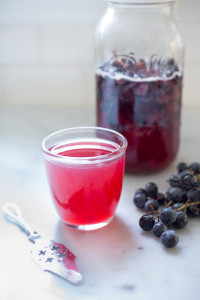
A simple guide to making Water Kefir-a refreshing probiotic fruit-infused drink made with water kefir grains (cactus grains) that is bubbly, effervescent and so healthy!
Optional Additions- fresh ginger, whole spices, herbs.
Equipment:
Sugar Mixture: (optional, but highly nutritious to you kefir grains)
Yes, feel free to halve the recipe.
It is OK to use frozen berries or fruit.
YES, you can get by with two 2-quart mason jars ( instead of 3). Strain one of the kefir jars into a pitcher, temporarily, rinse out the mason jar, add the fruit to this one, and pour in strained kefir water form pitcher and 2nd jar. Get it? 😉
Adding the lemon helps prevents kahm yeast, and the prune really adds flavor and helps with fermentation.
Kahm Yeast: If you see a white yeast on top of your second ferment, it is most likely kahm yeast. It’s harmless but can affect the taste. If you have Kahm yeast, make sure to rinse your kefir grains in pure clean water before storing in a clean jar with no soap residue. Cover with clean water and feed. This should hopefully prevent it from coming again. Make sure to add Citrus to your kefir water. Make sure all jars are clean. Leave less headroom at the top of the jar for oxygen to get in, during the second fermentation. Rinse your fruit before using, this can introduce the yeast. Sometimes it can grow if the environment is too warm.
How to maintain/grow your kefir grains:
The kefir grains that you strained out earlier can be stored in a smaller 8-ounce jar, in the fridge in the extra water kefir you will have after you merge the two jars into one. Add more water to fill and 1 tablespoon sugar.
We appreciate your feedback! Our readers LOVE to read your reviews, adaptations, and suggestions! Have a question? We’ll personally respond within 24 hours.
Share this with the world!